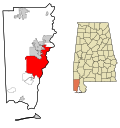U. J. Cleveland House | |
 | |
| Location | 551 Charles Street, Mobile, Alabama |
|---|---|
| Coordinates | 30°40′35″N88°3′24″W / 30.67639°N 88.05667°W |
| Area | less than one acre |
| Built | 1853 |
| Architectural style | Gulf Coast Cottage |
| NRHP reference No. | 93000420 [1] |
| Added to NRHP | May 21, 1993 |
The U. J. Cleveland House (also known as the Thomas Smith House) is a historic house located at 551 Charles Street in Mobile, Alabama. It is locally significant as an intact Gulf Coast Cottage with an unusual interior plan.





